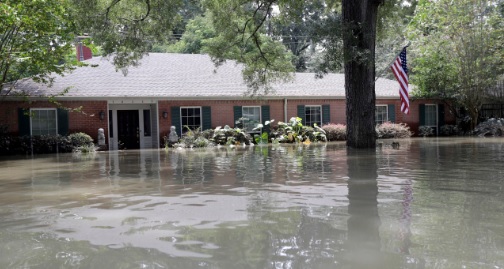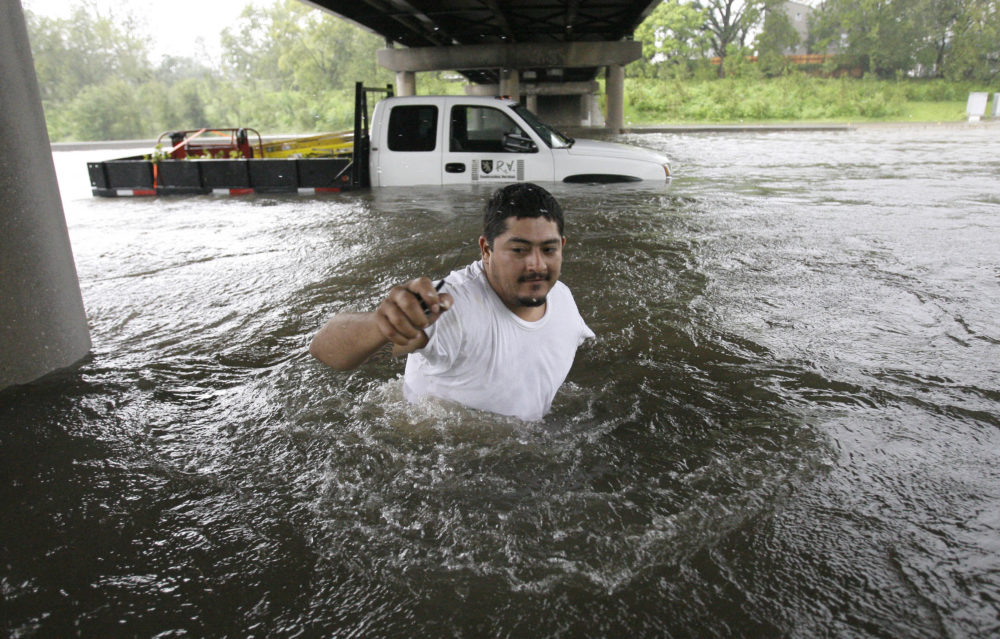- EF-1 tornadoes ripped through Cypress, Waller County areas with winds at more than 100 mph, NWS reports
- Houston-area storm damage updates: Clean up continues after NWS says two EF-1 tornadoes and powerful derecho ripped through SE Texas
- Low risk of damaging winds, hail from Saturday storms
- EF 1 tornadoes ripped through Cypress, Waller County areas at more than 100 mph, NWS reports
- Caddo Mounds State Historic Site to celebrate new visitor center, traditional grass house after 2019 tornado
A Houston Newcomers Guide To Hurricanes And Storm Prep
 After Hurricane Harvey hit the Texas coast in August 2017, the storm stalled over Houston and dumped as much as 60 inches of rain on some parts of the region.
After Hurricane Harvey hit the Texas coast in August 2017, the storm stalled over Houston and dumped as much as 60 inches of rain on some parts of the region.
For those who are new to Houston, hurricane and storm preparation can seem intimidating. But even for Houstonians whose family has lived here for generations, it never hurts to have a few new storm tricks up your sleeve. In the midst of hurricane season, here’s what you need to know about handling a hurricane or tropical storm, starting with the basics.
What counts as a hurricane?
The National Oceanic and Atmospheric Administration (NOAA) uses the term tropical cyclone to describe a rotating system of clouds and thunderstorms that forms over a large body of water. There are several types of tropical cyclones, ranging from a tropical depression to a hurricane being the most severe.
Tropical depressions have winds less than 39 mph. If the maximum sustained winds grow faster than 39 mph, the cyclone becomes a tropical storm. And a hurricane forms when the maximum sustained winds reach 74 mph. Hurricanes are then rated on a 1 to 5 scale, based on wind speed, with a 5 indicating “catastrophic damage will occur.”
Hurricane season in the Atlantic runs from June 1 to November 30, as the majority of storms occur during that time period.
What is the difference between a hurricane warning and a hurricane watch?
When listening to or reading storm coverage, you might hear the terms “hurricane warning” and “hurricane watch.” These terms, although similar, have certain distinctions. According to NOAA, when a hurricane watch is issued, it means hurricane conditions are possible. This is not as severe as a hurricane warning, which means that meteorologists expect hurricane conditions to occur.
 A United States flag hangs outside a flooded home in the aftermath of Hurricane Harvey, Monday, Sept. 4, 2017 in Houston.
A United States flag hangs outside a flooded home in the aftermath of Hurricane Harvey, Monday, Sept. 4, 2017 in Houston.
How can I prepare when I know a storm is approaching?
Mark Sloan from the Harris County Office of Homeland Security and Emergency Management previously told Houston Public Media that he encourages Houstonians to fill their gas tanks before the storm hits.
“During hurricane season, if your tank is half full, consider it empty,” Sloan said.
 A sign at Home Depot urges customers to stock up for potential storms.
A sign at Home Depot urges customers to stock up for potential storms.
Sloan also urged Houstonians to put together a storm kit, which he said should last up to seven days. Here are some storm kit essentials, according to Sloan and an emergency packing list from Ready Harris.
- Radio (preferably hand-cranked so that it can charge other electronic devices as well)
- Driver’s license/ID
- Insurance and other important documents (either stored in a resealable waterproof bag, saved on a flash drive, or snapped in pictures on your phone)
- Water (one gallon per day per person)
- Non-perishable or canned foods
- Note that some canned foods are perishable
- Foods that do not require cooking or refrigeration
- Can opener
- Plastic dishware
- Dry clothes and shoes
- Blanket/bedding for each person
- Toiletries
- Vision products
- Hand sanitizer
If families are not evacuating, Sloan suggests filling bathtubs with water. This water, he said, could be boiled and used for drinking or used to flush toilets in case of a power outage.
The Ready Campaign, a national public service campaign for emergencies, also encourages signing up for community warning systems, such as the Emergency Alert System (EAS) and the NOAA warning system, and bookmarking city websites for easy access to storm alerts. In Harris County, the information is available at Ready Harris. There, you can sign up to receive emergency alerts, download a hurricane checklist and access a map with evacuation routes. You can also find your local Office of Emergency Management, here.
 Joe Rodriguez wades through floodwaters caused by Hurricane Ike as he abandons his stalled truck Saturday, Sept. 13, 2008 in Houston.
Joe Rodriguez wades through floodwaters caused by Hurricane Ike as he abandons his stalled truck Saturday, Sept. 13, 2008 in Houston.
What should I do during a hurricane?
The Ready Campaign’s first tip is to take shelter in a storm-safe area, such as a windowless interior room or hallway on the lowest non-flooding floor. The campaign also advises people to listen for storm alerts and emergency information.
If told to do so, citizens should evacuate. However, the Ready Campaign urges people to follow the “Turn Around, Don’t Drown!” motto, which discourages anyone from walking, swimming, or driving through flood waters.
What happens after the storm?
Even when the storm is over, challenges still lie ahead. Here are some of the Ready Campaign’s post-storm tips:
- Wear protective clothing during cleanup in case of any dangerous debris or sharp edges
- Don’t wade in flood water, which could also contain storm debris
- Contact loved ones via text or social media rather than calls, as phone systems are often down or busy right after storms
- Take photos of any property damage for insurance purposes
- Contact insurance companies
For more information on what to do during and after a storm, visit https://www.readyharris.org/